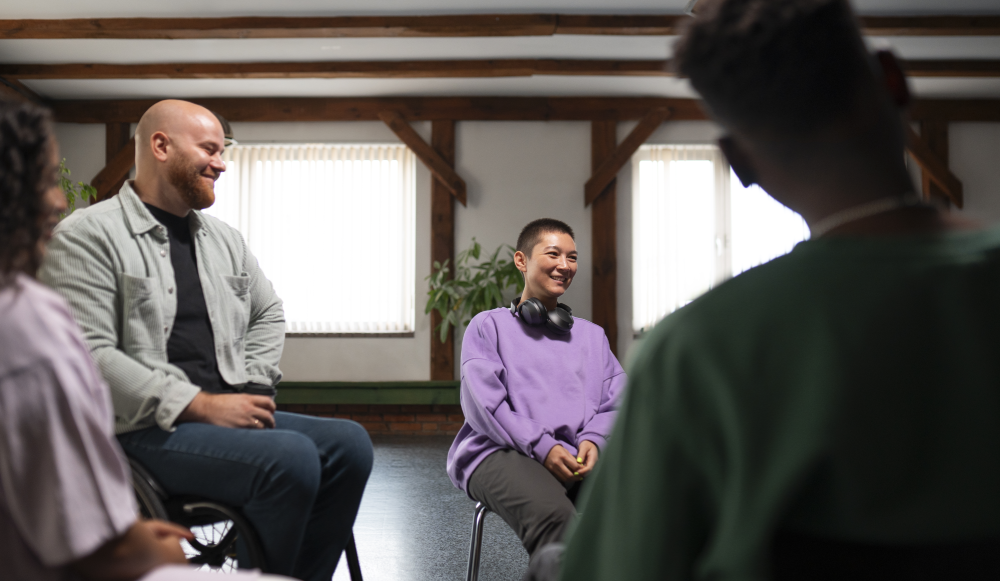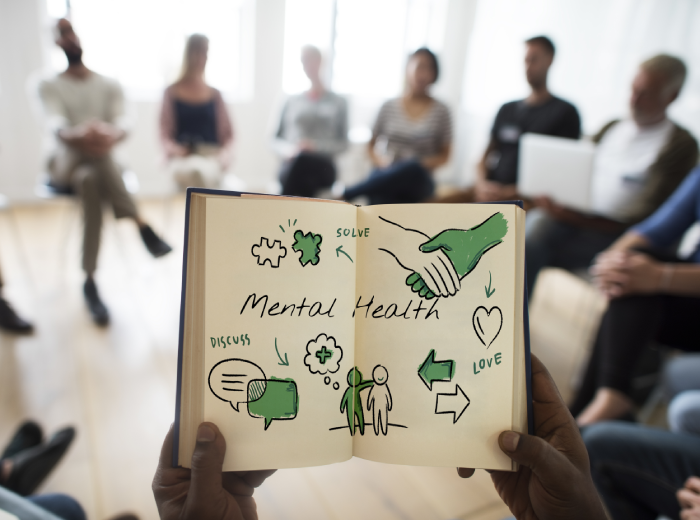- Home
- Learn
- Healthcare
- Community outreach strategies for mental-health professionals
HEALTHCARE
Community outreach strategies for mental-health professionals
Contents
Many people who need mental health support never reach out for help, often because they don’t know where to begin or fear being judged.
Community outreach is one of the most powerful ways mental health professionals can connect with people who might otherwise never seek help. It’s about stepping outside the clinic walls: into schools, workplaces, neighborhoods, and online spaces, to raise people’s awareness and make support easier to access for them.
In this article, we’ll look at some of the best community outreach strategies for mental health organizations of all sizes. You’ll learn how to understand your community’s needs, partner with local groups, measure impact, and use technology — like a HIPAA-compliant healthcare CRM — to manage relationships with your client base while maintaining full data privacy.

Mental health challenges affect people from every background, yet many never reach out for help. Some don’t know where to begin; others worry about stigma, and in many areas, services feel too far away or hard to access.
Community outreach helps bridge that gap.
When mental health professionals engage with their communities (be it through workshops, school talks, health fairs, or partnerships with local groups), they make care feel easier and approachable. Outreach encourages earlier help-seeking, which can prevent crises and improve long-term outcomes.
In fact, research has found that community-based interventions, including outreach programs, school partnerships, and public education campaigns, increase the likelihood that people seek mental health care earlier.
Outreach also builds vital connections between mental health providers and other local services — such as schools, primary care, social programs, or faith-based organizations. These partnerships create stronger referral networks, so individuals can be guided to the right resources faster.
In short, good community outreach helps reduce barriers like stigma, distance, and lack of information — turning mental health care from something distant and intimidating into something local and trusted.
A great example of the power of outreach comes from academia. Dr. Laurie Santos, a Yale professor, created the course “Psychology and the Good Life” after seeing rising levels of stress and unhappiness among her students. What began as a response to a community need soon grew into Yale’s most popular class; so many students enrolled that the university had to move it to a concert hall.
The course’s success demonstrates how listening to your community and responding to their real challenges can create a lasting, large-scale impact. For mental health professionals, that same principle applies.

Before launching any community outreach program, it’s essential to truly understand what your community needs and how they prefer to receive help.
Many well-intentioned mental health initiatives fail because they’re based on assumptions rather than real insights. A proper needs assessment helps mental health professionals listen first — and design outreach that’s relevant and effective.
Start by gathering information from multiple sources. You can:
Once the information is collected, look for patterns. For example, if many people mention stress among teens, or long wait times for counseling, use those insights to prioritize outreach programs that directly address these issues.
It’s also important to involve diverse voices (community leaders, cultural representatives, and people with lived experience) to ensure your outreach feels inclusive and trustworthy.
If resources are limited, low-cost tools like Google Forms, in-person questionnaires, or quick interviews at community events work just as well. As recommended by the Center for Health Care Strategies (CHCS), maintaining cultural competence (being aware of local beliefs, language, and stigma) helps ensure your outreach truly connects with those you aim to serve.
Community outreach becomes far more powerful when it’s not done alone. Mental health professionals can achieve greater impact by partnering with other organizations that already serve the same people, such as schools, primary care clinics, social service agencies, faith-based groups, NGOs, and even local employers.
Each partner brings unique strengths. For example, schools can help reach young people early and normalize mental health discussions. Primary care providers can refer patients who show signs of anxiety or depression. Faith leaders often have deep trust within communities that may otherwise avoid clinical settings. Employers and nonprofits can host workplace mental wellness programs or awareness workshops.
The first step is to identify who’s already active in your area. Attend local health coalition meetings, community fairs, or even virtual networking sessions to connect with potential collaborators. When you find a good fit, start small — perhaps co-hosting a mental health awareness event or sharing educational materials.
To make collaborations sustainable, consider setting up simple Memorandums of Understanding (MOUs). These are written agreements that outline each partner’s roles, responsibilities, and communication methods. This keeps expectations clear and builds accountability.
You can also develop referral pathways, so if a teacher, nurse, or social worker encounters someone in need of mental health support, they know exactly where and how to connect them to your services.
Organizations like the National Network of Libraries of Medicine (NNLM) provide free toolkits and templates for partnership planning, MOUs, and joint outreach events. These resources help formalize relationships and ensure that everyone works toward shared goals.

Once you understand your community’s needs and partners, the next step is turning that insight into practical outreach programs that people will attend and benefit from. The key is to choose the right type of event for your audience and make it as welcoming and accessible as possible.
Here are some effective outreach formats mental health professionals often use:
Workshops and seminars
Great for awareness and education. Topics like “Coping with Stress at Work” or “Supporting a Teen’s Mental Health” can be hosted at schools, workplaces, or community centers.
Wellness fairs or pop-up clinics
Partner with local health providers to offer free screenings, brief consultations, or relaxation activities. These attract people who might not otherwise seek mental health support.
Support groups or peer-led sessions
Create safe spaces for people with shared experiences (like new parents, veterans, or caregivers) to talk, learn coping skills, and connect.
Mobile or outreach clinics
Especially valuable for rural or underserved areas where access is limited. These bring services — like counseling, assessments, or referrals — directly to communities.
Culturally tailored programs
Design activities that reflect local languages, traditions, or faith values. This builds trust and makes mental health care feel more relatable.
When planning any event, accessibility is key. Choose convenient times (like evenings or weekends), ensure your location is easy to reach by public transport, and consider providing childcare or translation services if needed.
To run a successful event:
As highlighted SAMHSA, outreach works best when it’s consistent, inclusive, and built on trust — not just a one-time event, but part of an ongoing community presence.
Community outreach is no longer limited to local events or face-to-face interactions. Today, many mental health professionals use both in-person and online methods to reach people, educate them, and provide ongoing support. This is often called a hybrid outreach approach — combining the personal connection of community engagement with the convenience and reach of digital tools.
One of the simplest ways to use digital tools is through an online registration form for your workshops, webinars, or community sessions.
For example, you can use a form builder or your website to collect signups. These forms can be connected to a Customer Relationship Management (CRM) system, which is a type of software that helps healthcare professionals store contact information securely, track engagement, and send timely follow-ups.
If you’re using a healthcare-specific, HIPAA-compliant CRM like LeadSquared, it can be configured to automatically capture data from these forms and organize it safely. That means once someone registers for an event, their details appear in your system — allowing you to send them thank-you emails, reminders, educational resources, or invitations to future programs without manual effort.
Social media platforms such as Facebook, Instagram, LinkedIn, and YouTube are powerful extensions of community outreach. They allow you to share short educational videos, infographics, and posts that normalize mental health conversations. You can also promote upcoming events or resources through targeted local ads, which are affordable and help reach people who might not see your messages otherwise.
Digital tools also make it easier to reach people who might not attend in-person events — such as those in rural areas, caregivers who can’t travel, or individuals who prefer privacy. Hosting webinars or virtual support groups gives them a safe and accessible way to participate.
Once your outreach programs are in motion, you need to know if they’re actually helping the people you want to reach. Measuring impact simply means tracking what you did and what changed as a result.
Tracking results helps you decide which activities are worth repeating or adjusting. It also gives you data to share with funders or partners when planning the next round of programs.
Start with a few key areas:
If you’re working with partners, you can also ask if they’ve noticed more people being referred for support.
At first, you can use simple tools like sign-in sheets, spreadsheets, or Google Forms to track the key metric. But over time, a Customer Relationship Management (CRM) system can help you keep all this information organized in one place. You can set it up so that when someone registers for an event or downloads a resource, their information automatically feeds into the CRM. This makes it easier to see patterns — for instance, how many people who attended a webinar later booked a session.
Look at the data and ask simple questions:
If one approach works well, build on it. If another doesn’t, try changing the timing, location, or format.
Community outreach often means connecting with many people across events, online campaigns, and partner referrals. Keeping track of everyone (who attended, who followed up, and so on) is no easy task to get done manually. That’s where a Customer Relationship Management (CRM) system designed for healthcare can help.
Here’s how it works in practice:
At community events, mental health professionals can use digital forms or QR codes for attendees to sign up for updates or resources. Their details automatically (or through a quick import) will then go into the CRM.
Healthcare CRMs, like LeadSquared, follow privacy regulations like HIPAA in the U.S. (or regional equivalents elsewhere), meaning data such as names, contact details, or referral notes are stored securely and can only be accessed by authorized staff.
You can group contacts by location, age group, or interest (for example, “stress management workshop attendees” or “parents of teens”). Then, set up automated follow-ups: such as sending a thank-you email after an event, followed by a helpful resource and a link to schedule a counseling session.
When a community partner refers someone, the CRM records that referral and helps you track whether they were contacted and supported.
A healthcare CRM software, such as LeadSquared, can generate reports on how many people attended, how many followed up, and which outreach efforts led to the most engagement for you.
| Idea | Description |
| School Q&A session | Arrange a 30-minute “Ask the Counselor” session at a local high school. A mental health professional answers student questions about stress, anxiety, or peer pressure. |
| Workplace lunch-and-learn | Partner with a local employer to host a casual lunchtime talk: “Managing Work Stress & Burnout”. Provide free snacks and a quick self-help sheet. |
| Library resource boxes | Set up small displays in a public library: mental health pamphlets, QR codes linking to online screenings, and recommendation lists. |
| Mobile screening clinic | Use a mobile outreach unit (or partner with a local health van) and offer brief “check-in” mental health screenings (10 minutes) in neighborhoods with low access. |
| Peer support cohort | Launch a 6-week peer-led support group for parents of teens. Parents meet weekly, share experiences, and receive guidance from a facilitator. |
Community outreach in mental health starts with simple steps — listening to your community, building partnerships, testing small programs, and learning what works. Each effort, whether a school talk or a local workshop, helps break stigma and brings support closer to those who need it most.
As your outreach grows, using secure digital tools can make your work more effective. A HIPAA-compliant CRM like LeadSquared can help you manage contacts from events, track follow-ups, and stay connected with your community while keeping sensitive information safe.
If you’d like to see how LeadSquared can support your community outreach efforts, feel free to book a quick demo.
Community outreach strategies for mental health professionals refer to the intentional efforts to connect with people where they live, work or play—rather than only waiting for clients to come to you. This might include workshops at schools, partnerships with local non-profits, or online sessions for rural communities. These strategies help build trust, reduce stigma, and encourage earlier help-seeking by making mental health support more visible and accessible.
Choosing the right audience means thinking about who your organization serves best and where there is a gap in care. You might ask: Are you seeing many youths who struggle with exam stress? Or are caregivers of older adults underserved? Once you pick your audience, tailor your message and outreach location accordingly. A practical tool like LeadSquared (a healthcare-friendly CRM) can help you track which audience segments engage most with your outreach activities.
Starting small is perfectly fine. You don’t need a full-scale campaign right away. Try devoting one half-day a month to an outreach event (e.g., a workshop or webinar) and follow it up with a short email or resource. Over time, you can increase frequency. Using a CRM such as LeadSquared makes it easier to set up recurring outreach and track follow-up without it becoming overwhelming.
Digital-only outreach is valid and often necessary (especially for remote or busy populations). You could run a webinar, share a social-media Q&A, or partner with a local online community. But combining online with in-person or live elements will increase engagement.
Effectiveness comes down to tracking simple outcomes: how many people you reached, how many attended or responded, and whether any followed up for further support. Use short surveys, attendance lists, or digital analytics. Over time you’ll see patterns (e.g., which locations or topics attract the most interest). A CRM like LeadSquared can help you save all these details in one place, run follow-up sequences, and generate reports. That way you can refine your strategies rather than guessing what’s working.